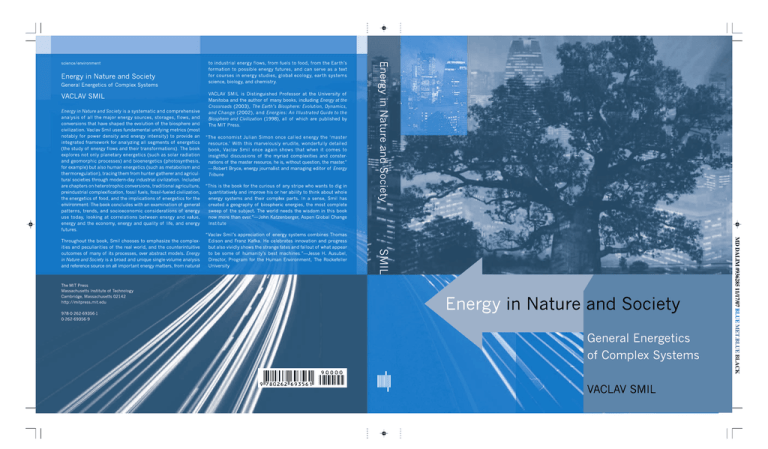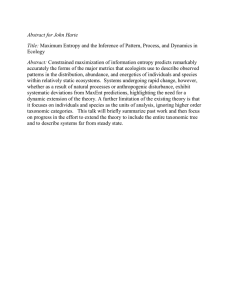
VACLAV SMIL
Energy in Nature and Society
General Energetics of Complex Systems
The MIT Press
Cambridge, Massachusetts
London, England
( 2008 Massachusetts Institute of Technology
All rights reserved. No part of this book may be reproduced in any form by any electronic or mechanical means
(including photocopying, recording, or information storage and retrieval) without permission in writing from the
publisher.
For information about special quantity discounts, please
email special_sales@mitpress.mit.edu
This book was set in Galliard, Bodoni, and Futura on
3B2 by Asco Typesetters, Hong Kong.
Printed on recycled paper and bound in the United
States of America.
Library of Congress Cataloging-in-Publication Data
Smil, Vaclav.
Energy in nature and society : general energetics of
complex systems / Vaclav Smil.
p.
cm.
Includes bibliographical references and index.
ISBN 978-0-262-19565-2 (hardcover : alk. paper)—
978-0-262-69356-1 (pbk.: alk. paper)
1. Bioenergetics. 2. Energy budget (Geophysics)
I. Title.
QH510.S63
2008
0
577 .13—dc22
10
9 8
7 6
2007002801
5 4
3 2 1
PREFACE
Energy is the only life and is
consequences in the Earth’s biosphere and throughout
from the Body;
the history of civilizations than was available at that time
and Reason is the bound or outward
in any single volume. The second goal was pursued by
circumference of Energy.
using fundamental unifying metrics, most notably power
Energy is Eternal Delight.
density (W/m 2 ) and energy intensity (J/g) values. By far
William Blake, The Marriage of Heaven and Hell (1793)
the most difficult task was to make sure that the forest of
grand energy principles would not be obscured by the
Energy’s definition in Blake’s poem comes from the
necessary focus on specific trees: inevitably, the book
Devil, as he corrects what he feels to be one of the prin-
had to have thousands of numbers, and their torrent
cipal errors of sacred codes, namely, ‘‘That Energy, call’d
could be overwhelming.
Evil, is alone from the Body; & that Reason, call’d Good,
General Energetics: Energy in the Biosphere and Civili-
is alone from the Soul.’’ This book is preoccupied with
zation was published in 1991. Although it did not make
more pragmatic and less contentious propositions, but it
waves compared to several of my ‘‘bestsellers,’’ it found
too owes its existence to fascination with energy’s elusive
appreciative readers. My greatest satisfaction came from
qualities.
the judgment by Philip Morrison, for decades my model
I wrote this opening paragraph in 1987 as I was begin-
of clear and captivating scientific writing, who in Scien-
ning to work on what was intended to be both a compre-
tific American called the book ‘‘a work of tightly con-
hensive and an analytically unified survey of energy. The
trolled audacity. . . . The pleasure and stimulation of the
first goal was met by offering a more sweeping treatment
book come from its critical display of . . . unruly realities:
of energy sources, flows, conversions, uses, and their
its importance from the fact that serious argument on
x
any of these matters must take into account this army of
objective thus remains the same as for General Energetics,
decisive magnitudes Professor Smil has marshaled.’’
so I end this preface by amending only slightly the clos-
For me General Energetics was an unprecedented proj-
ing paragraphs that I wrote in 1987.
ect with multiple challenges and rewards. It took much
I see a clear need for a book that not only embraces all
longer to complete than any other book I have written,
essential energy sources, storages, flows, and conversions
and the necessary research, endless calculations, and in-
in a unified and systematic manner but that does so by
termediate drafts turned up a great deal of fascinating
combining an encyclopedic sweep and richness of detail
information that had to be left out of that single volume.
with an evolutionary overview and analytical crispness,
Consequently, General Energetics led directly to Energy
and that does not shy away from grand synthesizing gen-
in World History (1994) and a few years later to Energies
eralizations or from acknowledging the inability to offer
(1998), and the work on several of its specific aspects also
such statements. This is no modest goal, but I believe
helped to inform parts of Cycles of Life (1997), Feeding
that Li Bo’s ancient acute observation—‘‘When the
the World (2000), The Earth’s Biosphere (2002), and En-
hunter sets traps only for rabbits, tigers and dragons are
ergy at the Crossroads (2003).
left uncaught’’—justifies the attempt.
As soon as the original book was published, I hoped
At the same time, this is also a very personal book. My
that one day I could prepare a revised edition, but the
fascination with energetics has been going on for more
continuing flood of new energy studies made it clear
than 40 years, and new topics keep coming into closer
that a mere revision was not the way to go. My intent
focus. My interest in planetary energy flows and in bio-
then became to retain the book’s original divisions (com-
energetics started with university studies of climatology,
bining chapters 5 and 6 was the only major change) but
geomorphology, zoology, and ecology, and these fields
with deletions, rewrites, elaborations, expansions, intro-
were soon augmented by work on energy economics,
ductions of new subjects, better illustrations, and more
coal mining, and power plant engineering. Principal
extensive references.
themes of my published energy research have been, chro-
The fundamental goal has not changed: to produce a
nologically, thermal electricity generation, acid deposi-
comprehensive, systematic, revealing (and hence interdis-
tion, coal mining, and internationalization of energy
ciplinary and quantitative) treatment of all major aspects
supply in the 1960s; atmospheric CO2 modeling, evolu-
of energy in nature and society. I believe the case for a
tion and forecasting of energy techniques, energy-
book like this is even more compelling now than it was
economy correlations, and energy in China and other
two decades ago. During the intervening years, energy
poor populous countries in the 1970s; biomass energies,
has become even more prominent as the subject of scien-
grand biospheric cycles, energy analysis in agriculture,
tific inquiry and public policy debates, and the conse-
energy in agriculture and in human nutrition, energy in
quences of its use raise even greater concern and anxiety,
world history, and global dimensions of energetics in the
but approaches to its understanding and rational man-
1980s and 1990s; and during the first years of a new mil-
agement continue to suffer from inadequate integration
lennium, energy’s role in the creation and transformation
and insufficient understanding of complex wholes. My
of modern civilization.
PREFACE
xi
A strong commonality tying these interests has been
my fascination with unruly and fuzzy realities in preference to abstract models and dubious generalizations.
Complexities and peculiarities of the real world and
counterintuitive outcomes of many of its processes have
seemed to me always more appealing than theoretical
models. This preference requires a from-the-ground-up
approach where gradual understanding of details and
cumulative acquisition of the widest possible scope of information precedes any attempts at generalization. Inevitably, this book is marked by these interests and biases,
but I have done my best to offer a balanced and comprehensive treatment free of excessive indulgence in favorite
topics.
The aims are broad interdisciplinary coverage, richness
of detail, clear analyses, syntheses rooted in the presented
information, and commonsense generalizations. The
means is a systematic and evolutionary account, but one
whose boundaries and flavors are also clearly influenced
by my scientific background, preferences, and lifelong
fascinations and inclinations. The book takes just one of
many possible routes to better understanding of energy
in nature and in human societies, and its inherent sweep
and complexity mean that it cannot be devoid of lapses
and errors. But even if it were to fall far short of its ambitious mark, there is, as always, consolation in the wisdom
of an ancient sage. Lao Zi, noting that it is void space
that makes bowls and houses useful, wrote,
So advantage is had
From whatever is there;
But usefulness rises
From whatever is not.
PREFACE


